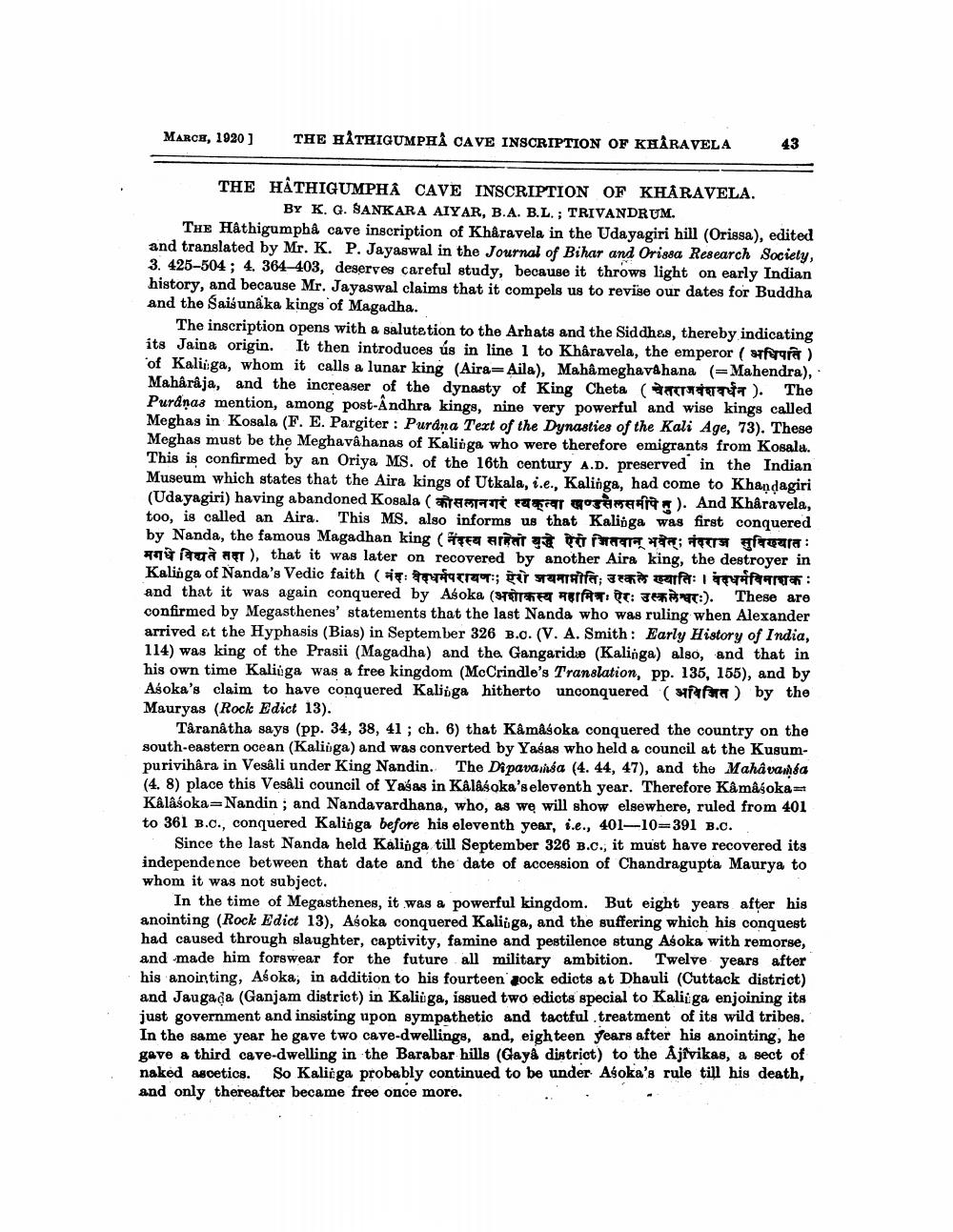________________
MARCE, 1020
THE HATHIGUMPH CAVE INSCRIPTION OF KHARAVELA
43
THE HÅTHIGUMPHÁ CAVE INSCRIPTION OF KHARAVELA.
BY K. G. SANKARA AIYAR, B.A. B.L.; TRIVANDRUM. THE HAthigumphå cave inscription of Khâravela in the Udayagiri hill (Orissa), edited and translated by Mr. K. P. Jayaswal in the Journal of Bihar and Orissa Research Society, 3. 425-504 ; 4. 364-403, deserves careful study, because it throws light on early Indian history, and because Mr. Jayaswal claims that it compels us to revise our dates for Buddha and the Sais unâka kings of Magadha.
The inscription opens with a salutation to the Arhats and the Siddhes, thereby indicating its Jaina origin. It then introduces ús in line 1 to Khâravela, the emperor (sfer) of Kalinga, whom it calls a lunar king (Aira-Aila), Mahâ meghavahana (=Mahendra), Maharaja, and the increaser of the dynasty of King Cheta ( TTT). The Purdņas mention, among post-Andhra kings, nine very powerful and wise kings called Meghag in Kosala (F. E. Pargiter : Purana Text of the Dynasties of the Kali Age, 73). These Meghas must be the Meghavahanas of Kalinga who were therefore emigrants from Kosala. This is confirmed by an Oriya MS. of the 16th century A.D. preserved in the Indian Museum which states that the Aira kings of Utkala, i.e., Kalinga, had come to Khandagiri (Udayagiri) having abandoned Kosala ( Marap at emaa). And Khåravela, too, is called an Aira. This MS. also informs us that Kalinga was first conquered by Nanda, the famous Magadhan king (HES ART TO T ; T ftuar:
gà a ), that it was later on recovered by another Aira king, the destroyer in Kalinga of Nanda's Vedic faith (iş a ret; i anata; atas na: IVA : and that it was again conquered by Asoka (TÈTRT FIAT: OT: R T:). These are confirmed by Megasthenes' statements that the last Nanda who was ruling when Alexander arrived at the Hyphasis (Bias) in September 326 B... (V. A. Smith: Early History of India, 114) was king of the Prasii (Magadha) and the Gangaridze (Kalinga) also, and that in his own time Kaliiga was a free kingdom (McCrindle's Translation, pp. 135, 155), and by Asoka's claim to have conquered Kaliiga hitherto unconquered ( af ) by the Mauryas (Rock Edict 13).
Taranatha says (pp. 34, 38, 41 ; ch. 6) that Kamasoka conquered the country on the south-eastern ocean (Kaliūga) and was converted by Yasas who held a council at the Kusumpurivihâra in Vesali under King Nandin. The Di pavainsa (4. 44, 47), and the Mahavamsa (4. 8) place this Vesali council of Yaşas in Kalásoka's eleventh year. Therefore Kâmásokat Kâlâśoka=Nandin; and Nandavardhana, who, as we will show elsewhere, ruled from 401 to 361 B.c., conquered Kalinga before his eleventh year, i.e., 401-10=391 B.c.
Since the last Nanda held Kalinga till September 326 B.C., it must have recovered its independence between that date and the date of accession of Chandragupta Maurya to whom it was not subject.
In the time of Megasthenes, it was a powerful kingdom. But eight years after his anointing (Rock Edict 13), Asoka conquered Kaliiga, and the suffering which his conquest had caused through slaughter, captivity, famine and pestilence stung Asoka with remorse, and made him forswear for the future all military ambition. Twelve years after his anointing, Asoka, in addition to his fourteen zock edicts at Dhauli (Cuttack district) and Jau gada (Ganjam district) in Kaliiga, issued two edicts special to Kaliiga enjoining its just government and insisting upon sympathetic and tactful treatment of its wild tribes. In the same year he gave two cave-dwellings, and, eighteen years after his anointing, he gave a third cave-dwelling in the Barabar hills (Gayà district) to the Ajivikas, a sect of naked ascetics. So Kaliiga probably continued to be under Asoka's rule till his death, and only thereafter became free once more.




